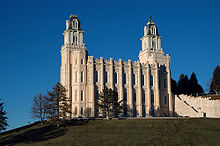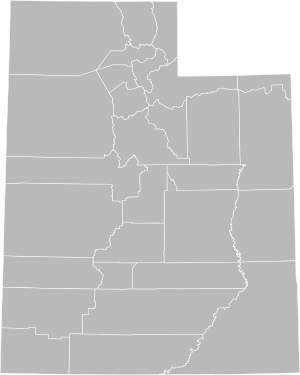- Manti Utah Temple
-
Manti Utah Temple 
Number 3 Dedication 21 May 1888 by
Lorenzo SnowSite 27 acres (10.9 hectares) Floor area 100,373 sq ft (9,325 m2) Height 179 ft (55 m) Preceded by Logan Utah Temple Followed by Salt Lake Temple Official website • News & Images Additional Information Announcement 25 June 1875 Groundbreaking 25 April 1877 by
Brigham YoungOpen House 6–8 June 1985 Rededication 14 June 1985 by
Gordon B. HinckleyDesigned by William H. Folsom Location Temple Hill
Manti, Utah 84642
United StatesPhone number 435-835-2291 Exterior finish cream-colored oolite limestone Temple design Castellated Gothic/French Renaissance Ordinance rooms 4 with Live, four-stage progressive sessions Sealing rooms 8 Clothing rental Yes Cafeteria Full services Visitors' center No Notes Wilford Woodruff performed a private dedication on May 17, 1888.[1] Coordinates: 39°16′22.46159″N 111°38′1.535999″W / 39.2729059972°N 111.63375999972°W The Manti Utah Temple (formerly the Manti Temple) is the fifth constructed temple of The Church of Jesus Christ of Latter-day Saints (the Mormons). Located in the city of Manti, Utah, it was the third LDS temple built west of the Mississippi River after the Mormons' great trek westward. (The St. George and Logan Utah temples preceded it.) The Manti Utah Temple was designed by William Harrison Folsom, who moved to Manti while the temple was under construction. The temple dominates the Sanpete Valley, and can be seen from many miles. Like all LDS temples, only church members in good standing may enter. It is one of only two remaining LDS temples in the world where live actors are used in the endowment ceremonies (the other is the Salt Lake Temple); all other temples use films in their rituals.[2]
Contents
History
The decision to build an LDS temple in Manti was announced on June 25, 1875 by Brigham Young. The Salt Lake Temple was announced years before in 1847, but construction was still underway and not finished until 1893. The Manti Temple was built, along with the St. George and Logan temples, to satisfy the church's immediate need for these structures. The site for the temple was the Manti Stone Quarry, a large hill immediately northeast of town. Early Mormon settlers in the area had prophesied that this would be the site of a temple. When Brigham Young announced the building of the temple, he also announced that the 27-acre (110,000 m2) plot would then be known as "Temple Hill."
The temple was completed in 1888, and a private dedication was held on May 17, 1888, with the prayer given by Wilford Woodruff. Three public dedications were held on May 21–23, 1888, and were directed by Lorenzo Snow.
The Manti Temple was the location of the Holy of Holies until the Salt Lake Temple was dedicated. The room was then used for sealings until it was closed in the late 1970s.
Renovations
The Manti Temple has undergone various remodeling and renovations. Construction of a great stone stairway leading up the hill to the west temple doors began in 1907. In 1935, the temple was fully lit at night for the first time. In 1940 the stone stairs were removed and work began to beautify the grounds. Between 1944 and 1945 the annex, chapel, kitchen, Garden Room, and men’s and women’s areas were remodeled. There was once a tunnel beneath the east tower of the temple through which wagons and cars could pass, but it was closed off in the 1960s.
In 1981 church officials decided that the interior of the temple needed extensive remodeling. The renovation took four years, during which murals and original furniture were restored, offices were enlarged and remodeled, a separate door was made to the baptistery, water and weather damage were repaired, an elevator was installed, and locker rooms were improved among many other projects. In June 1985, Gordon B. Hinckley directed the rededication ceremonies.
Style
The Manti Temple combines the Gothic Revival, French Renaissance Revival, French Second Empire, and Colonial architectural styles. The temple has 100,373 square feet (9,325.0 m2) of floor space, eight sealing rooms, four ordinance rooms, and a Celestial room. The exterior is made of fine-textured, cream-colored oolite limestone from quarries in the hill on which the temple now stands. The two towers of the temple are 179 feet (55 m) tall, and the open center spiral staircases inside the towers are marvels of pioneer ingenuity.
Temple Presidents
- Daniel H. Wells, 1888–1891
- Anthon H. Lund, 1891–1893
- John D. T. McAllister, 1893–1906
- Lewis Anderson, 1906–1933
- Robert D. Young, 1933–1943
- Lewis R. Anderson, 1943–1959
- A. Bent Peterson, 1959–1968
- Reuel E. Christensen, 1968–1974
- June W. Black, 1974–1978
- Wilbur W. Cox, 1978–1985
- Alma P. Burton, 1985–1988
- Earl R. Olsen, 1988–1991
- Garth P. Monson, 1991–1994
- Lee R. Barton, 1994–1997
- Graham W. Doxey, 1997–2000
- Jack H. Goaslind, 2000–2003
- Archie M. Brugger, 2003–2006
- J. Bruce Harless, 2006–2009
- Ed J. Pinegar, 2009–present
See also
- Temple (Latter Day Saints)
- List of temples of The Church of Jesus Christ of Latter-day Saints
- List of temples of The Church of Jesus Christ of Latter-day Saints by geographic region
- Comparison of temples of The Church of Jesus Christ of Latter-day Saints
- Mormon Miracle Pageant
- Temple architecture (Latter-day Saints)
- The Church of Jesus Christ of Latter-day Saints in Utah
Notes
- ^ Satterfield, Rick. Manti Utah Temple. ldschurchtemples.com. Retrieved on 23 December 2006.
- ^ Manti Temple Page.
External links
By county Latter-day Saint temples in Utah See also : Temples in other geographic regions Box Elder Brigham City Utah Temple (under construction)
•= Operating •= Construction •= Announced •= Closed Cache Davis Salt Lake San Juan Sanpete Manti Utah Temple
Uintah Utah Mount Timpanogos Utah Temple · Payson Utah Temple (under construction) · Provo Utah Tabernacle Temple (announced) · Provo Utah Temple
Washington Weber Categories:- Temples of The Church of Jesus Christ of Latter-day Saints in Utah
- Religious buildings completed in 1888
- Properties of religious function on the National Register of Historic Places in Utah
- Buildings and structures in Sanpete County, Utah
- 19th-century Latter Day Saint temples
Wikimedia Foundation. 2010.


